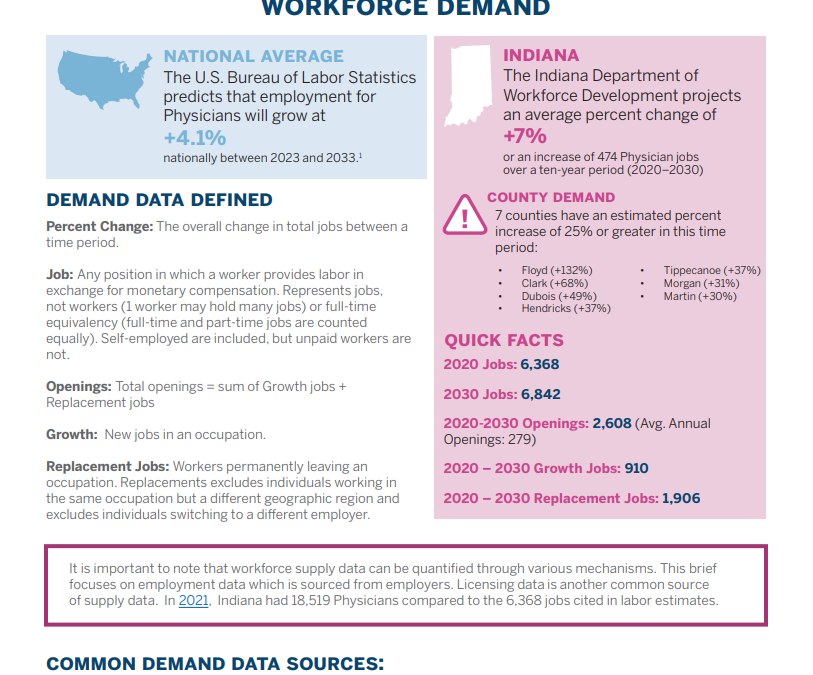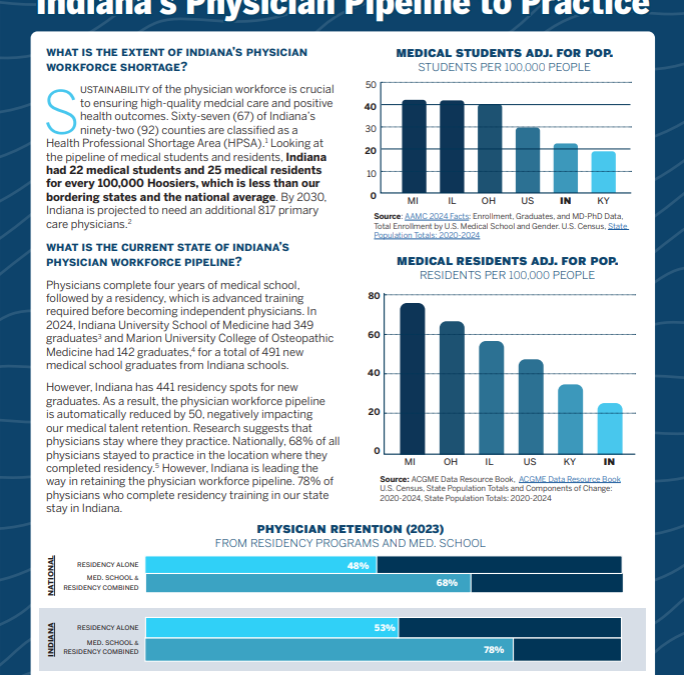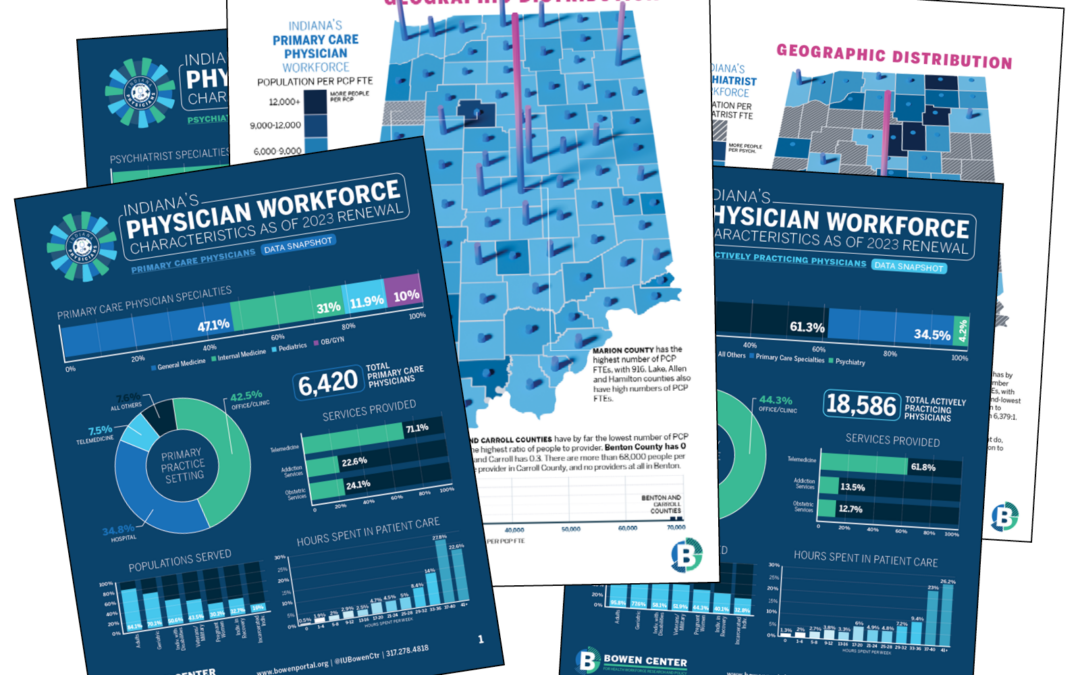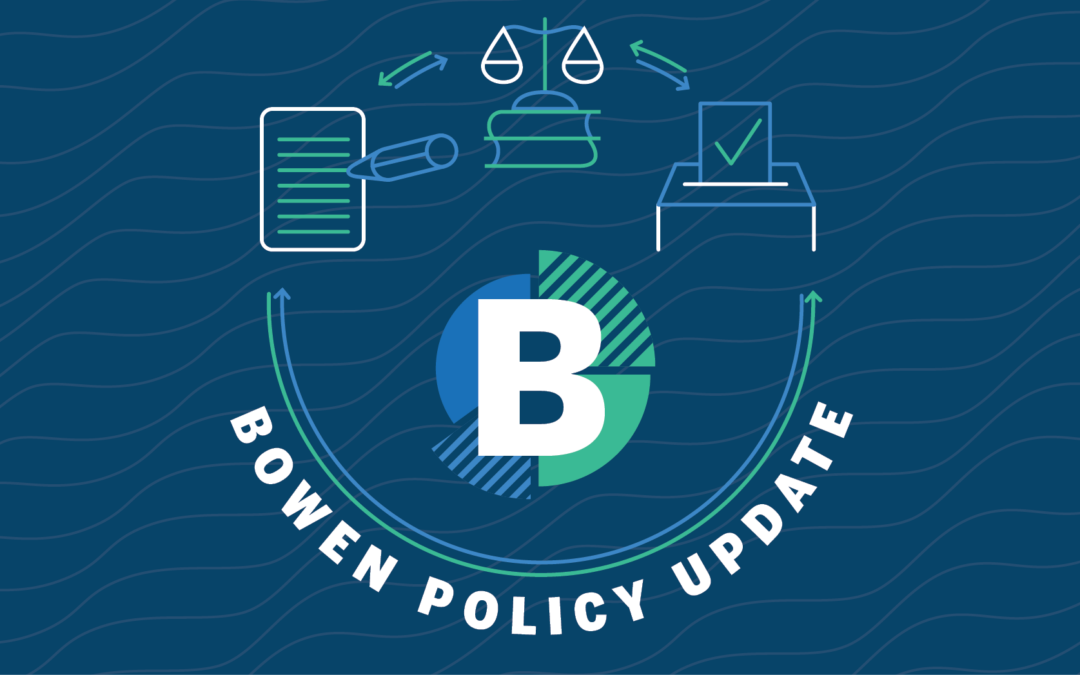
by Guest Author | Apr 23, 2025 | Policy, Reports
The 2023 Physicians Workforce Demand Brief describes the projected demand for physicians in Indiana using data from the Indiana Department of Workforce Development (DWD). According to the US Bureau of Labor Statistics, physician employment is projected to grow by 4.1% nationally between 2023 and 2033. In Indiana, the Department of Workforce Development forecasts a 7% increase, translating to 474 new physician jobs from 2020-2030.
The Demand brief also defines various terms related to demand projects and maps expected growth across Indiana’s counties. It serves as a valuable resource for understanding the evolving landscape of physician workforce needs in Indiana.
Check out the full brief below for more information and insights into the projected demand for physicians across the state.

by Guest Author | Apr 23, 2025 | Policy, Reports
We released a brief report describing how Indiana’s physician pipeline-to-practice compares to our neighboring states and now comes the Bowen Snapshot: Indiana’s Physician Pipeline-to-Practice. This Snapshot summarizes the information included in the brief in just two pages! We hope this document succinctly communicates the state of Indiana’s physician pipeline and opportunities for strengthening it.
In addition to summarizing the extent of Indiana’s physician workforce shortage by looking at medical student and medical resident capacity, the Snapshot uses national data to quantify the size of the physician pipeline in 2024. It also describes the variation in state incentives to support the retention of doctors.
For more detailed insights, refer to the full snapshot below.

by Guest Author | Mar 27, 2025 | Data
The Bowen Center for Health Workforce Research and Policy has released its latest data snapshots detailing Indiana’s physician workforce characteristics as of the 2023 license renewal process.
The three new reports cover:
- All Actively Practicing Physicians – With 18,586 physicians statewide, the data reveals that 61.3% of physicians reported practicing in specialties outside primary care, while 34.5% reported a focus on primary care and 4.2% on psychiatry. 61.8% of physicians reported providing telemedicine services.
- Primary Care Physicians – Indiana has 6,420 primary care physicians, with Family/General Medicine (47.1%) and Internal Medicine (31%) representing the largest specialties, as self-reported by Indiana primary care physicians. Over 71% reported providing telemedicine services, and nearly 23% reported offering addiction services.
- Psychiatrists – The state has 782 actively practicing psychiatrists, with 90.5% reporting a specialty of general psychiatry and 9.5% in child psychiatry. Notably, 31 counties report no psychiatrist FTEs, highlighting significant disparities in mental healthcare access across Indiana.
Each snapshot includes a detailed map of geographic distribution, showing both the number of each type of physician in each county, the per capita figures, and a histogram showing country distribution. Marion, Lake, Allen, and Hamilton counties showing the highest concentration of physicians, while rural counties like Benton and Carroll face major shortages.
Does Indiana physician health workforce data pique your interest? Take a deep dive into Indiana’s 2023 Physician Workforce Data Report, complete with interactive data and charts galore at this link.
Check out each of the snapshots directly below or download the documents using the links in the text above.
All Indiana Physicians Workforce Snapshot
Primary Care Physician Workforce Snapshot
Psychiatrist Workforce Snapshot:

by Guest Author | Mar 13, 2025 | News, Policy, Reports
The Bowen Center’s newly released 2024 Annual Report showcases a year of significant achievements in health workforce research and policy. Highlights include completing the Playbook for Enhancing Indiana’s Mental and Behavioral Health Workforce, assessing Indiana’s EMS workforce, and finalizing a three-year direct care workforce project.
Under Dr. Hannah Maxey’s leadership, the Center has enhanced its data collection partnerships with state agencies while expanding its communication strategy to ensure research reaches decision-makers who need it most.
With a combination of funding from public and private sources, the Center produced 63 publications, delivered 22 presentations, and saw significant increases in website and social media engagement in 2024, solidifying its role as Indiana’s premier resource for health workforce planning.
The report also features testimonials from partners including Indiana Lt. Governor Suzanne Crouch and Indiana Professional Licensing Agency Executive Director Lindsay Hyer, who emphasize the Center’s crucial role in transforming workforce data into evidence-based solutions for healthcare access challenges across the state.
Download the full report here or read it in full below:

by Guest Author | Mar 13, 2025 | Policy
Indiana faces dental workforce shortages, with 68% of its counties designated as Dental Health Professional Shortage Areas (HPSAs). This shortage impacts access to essential oral health services for many residents. The Bowen Center for Health Workforce reviewed the current state of dental health professionals in Indiana, comparing it with neighboring states, and examines the potential of the Dentist and Dental Hygienist Compact to address these workforce shortages. Discover how interstate compacts could enhance mobility and reduce regulatory barriers for dental professionals.
Click here to read the full report and learn more about the dental health workforce in Indiana.
Read the full brief below or download it here.





